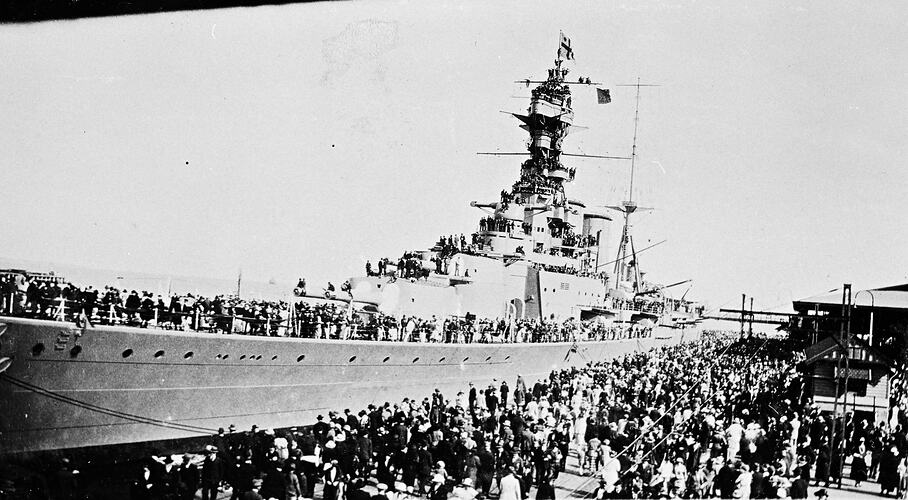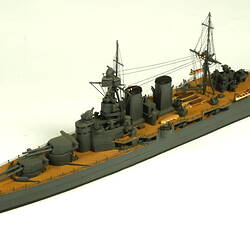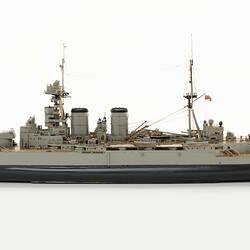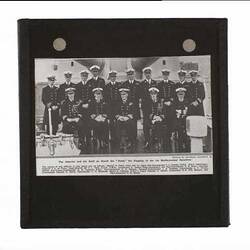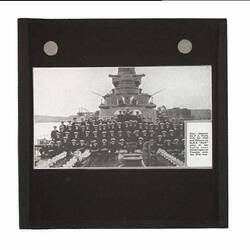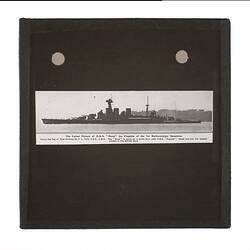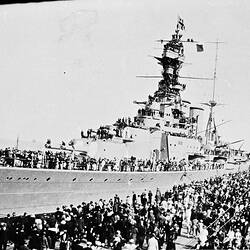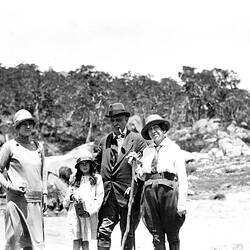Summary
Named after the 18th-century Admiral Samuel Hood, HMS Hood was the last battlecruiser built for the Royal Navy. Originally one of four Admiral-class battlecruisers ordered in mid-1916, she was the only one completed being commissioned in 1920 after extensive modifications bought about by a review of the Battle of Jutland, which showed up serious limitations in the original design. On launching she was the largest and most powerful warship in the British Navy and remained the pride of the fleet for a generation. HMS Hood was hit by enemy fire and sunk on 24 May 1941, with the loss of all but three of her crew, during the Battle of the Denmark Strait in which the British Navy attempted to block the escape of the German battleship Bismarck and heavy cruiser Prinz Eugen from the North Sea into the Atlantic Ocean.
HMS Hood visited Melbourne from Monday 17th March to Tuesday 25th March 1924, as flagship of the Special Service Battlecruiser Squadron, during an "Empire Cruise" around the world. For most of their stay in Melbourne, the five visiting warships were open to the public from 1.30 p.m. to 6.30 p.m. daily.
Description of Content
Crowds inspecting the visiting Admiral-class battlecruiser H.M.S. Hood of the Royal Navy, at the out east berth of Princes Pier, Port Melbourne in March 1924. An account published in the Melbourne newspaper "The Age", on 19th March, gives a vivid account of the crowds that flocked to see the vessels: "Many big crowds have been seen at Port Melbourne during the past 30 years, not only on the occasions of the Royal visit and visits by warships of different nations, but it is doubtful if any previous crowd could have compared in magnitude with the vast concourse which swarmed over the roads, piers and warships at Port Melbourne yesterday. As soon as the procession in the city was over a stampede set in to Flinders-street station, and for three hours afterwards a continuous stream of people poured in and crowded every train that went to Port Melbourne. Others in thousands journeyed by tram, chars-a-bancs, cab, and motor cars to the same destination, and by 3 p.m. the Railway and Princes Piers at Port Melbourne were thronged with men, women and children of all ages. Sizes and classes, and the five battleships which they all had gone to see were almost as crowded as the piers. It was estimated by police officers that the crowd numbered between 60,000 and 80,000 people. The greatest numbers patronised the Princes Pier, where the big battle cruisers Hood and Repulse are berthed, together with the light cruisers Delhi and Danae. Still the Town Pier, where the Dunedin is berthed, was more convenient for those who travelled by tram, and it also was thickly crowded. Anticipating the crowds during Fleet Week, proprietors of merry- go-rounds and side shows had established themselves in business along the foreshore, and enterprising purveyors of hot saveloys, peanuts and other delectable commodities had set up their stands along the roadway between the station and the piers. . Of course, the great attraction of the day was H.M.S. Hood, flagship of the squadron and the largest warship in the world." "The most remarkable feature was the manner in which a large but youthful section of the Melbourne public took possession of the Hood. While the crowds strolled over the decks of the big flagship hundreds of boys and young men swarmed up the iron ladders leading to the various bridges and landings around the great fore-mast, and for the greater part of the afternoon the front portion of the ship was suggestive of a swarm of black bees on tree trunks. Scouts and other small boys climbed up the rigging us high as they could go, and sat, with legs dangling, on the yard arms 100 feet up in the air. Others climbed up to the gun controls 50 feet above the deck, and slid down again on the ropes. More again swarmed round the turrets and manipulated the big guns raising, lowering and turning them in all directions. Another pastime favored by the youthful invaders was that of jumping and sliding on the spacious canvas awnings over the aft deck of the ship. It was all great fun. People on the pier watched with bated breath, and wondered why none of the young rascals fell from the dangerous heights. This went on all the afternoon. Young Australia had completely captured the flagship of the British Special Service Squadron, and nobody seemed to care - least of all the British officers and sailors."
More Information
-
Collection Names
-
Collecting Areas
-
Acquisition Information
Copied from Mary Lila Tanner, 08 Mar 1985
-
Place & Date Depicted
Princes Pier, Port Melbourne, Greater Melbourne, Victoria, Australia, Mar 1924
Location previously incorrectly identified as Station Pier. Record updated in response to Public Inquiry #58117, from Alan Marshall, 27/04/2018. -
Photographer
-
Ship Depicted
HMS Hood (Warship), Royal Navy (RN), 1920-1941
HMS Hood was ordered on 7th April 1916 from builder John Brown & Co. (yard number: 460), with the keel beig laid on 1st Sep 1916 and the ship launched on 22 Aug 1918, being commissioned into the Royal Navy on 15th May 1920. HMS Hood was sunk by German warships on 24th May 1941. -
Format
Negative, 35 mm, Black & White
-
Classification
-
Category
-
Discipline
-
Type of item
-
References
'GUIDE TO H.M.S. HOOD', The Argus (Melbourne), 15 Mar 1924, p.9, [Link 1] 'lnspecting the War Ships', The Age (Melbourne), 19 Mar 1924, p.11, [Link 2]
-
Keywords
Flags, Jetties, Military Forces, Naval Forces, Ships, British Fleet Visit to Melbourne, 1924
